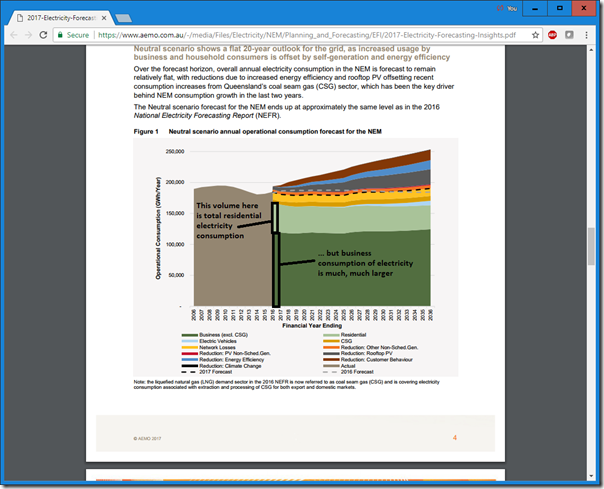In my presentation at the CEC’s Clean Energy Summit back on 19th July 2017, I spoke about some aspects of how I see we’ve been doing a pretty poor job of managing this broad energy transition to maximise the upsides, and minimise the downsides. In separate posts (which I’ll try to collect here under this “Energy Transition” category on WattClarity) I’ll be discussing various points in more detail.
In this post, I wanted to copy in the following chart from AEMO’s “2017 Electricity Forecasting Insights” report that I used on the day to illustrate how business use of electricity dwarfs residential use:
Yet this is not what an unknowledgeable outsider would assume, if they were to gauge by percentage of coverage in the mainstream media (and even on social media). Over the past decade I have come to the view that this aspect of poor energy literacy has led to unenvisaged consequences as we walk down the path of this energy transition.
In the chart AEMO provides on this page, we see that business sector annual consumption in the NEM was a little lower than 130,000GWh in 2016 (note that I don’t believe this covers the volume of consumption represented by new upstream compression of gas for export via LNG – this would be roughly 7,000GWh). In the same way, AEMO provides a chart on this page for residential electricity consumption shows it to be a little under 60,000GWh in 2017.
The main take-away, here, is that Business Sector annual electricity consumption is more than twice that of Residential Sector electricity consumption.
It is my belief that the current high share of electricity consumption across various sectors has arisen in the NEM (and similarly in the WEM, as well) for a variety of reasons – including:
1) the natural resources our country is blessed with especially in proportion to the small scale of our population,
2) historically positive government policies aimed at helping the country benefit from this resource base, and
3) our historically low cost of energy on the back of large volumes of coal-fired generation.
This starting position is meaning unique challenges for us in this energy transition.
I believe that this ratio is not as skewed in a number of other locations around the world. Some of our informed readers might like to provide some comparisons in comments below?



Leave a comment